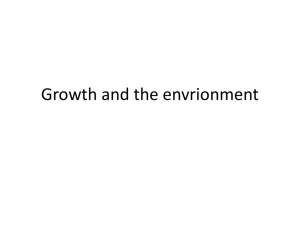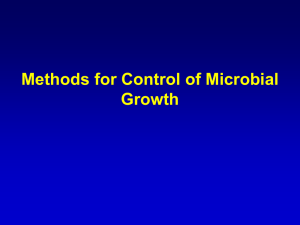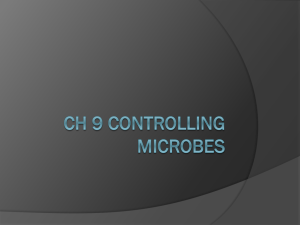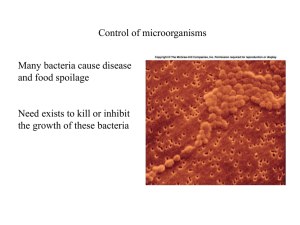Chapter 7: Control of Microorganisms: Physical and Chemical
advertisement
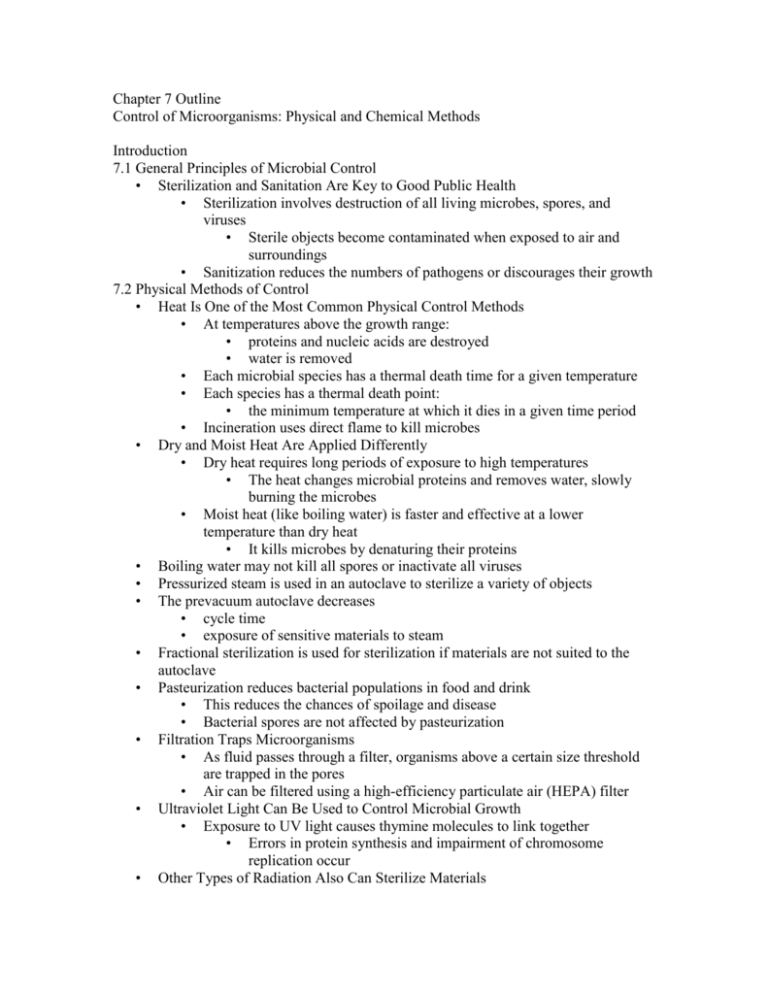
Chapter 7 Outline Control of Microorganisms: Physical and Chemical Methods Introduction 7.1 General Principles of Microbial Control • Sterilization and Sanitation Are Key to Good Public Health • Sterilization involves destruction of all living microbes, spores, and viruses • Sterile objects become contaminated when exposed to air and surroundings • Sanitization reduces the numbers of pathogens or discourages their growth 7.2 Physical Methods of Control • Heat Is One of the Most Common Physical Control Methods • At temperatures above the growth range: • proteins and nucleic acids are destroyed • water is removed • Each microbial species has a thermal death time for a given temperature • Each species has a thermal death point: • the minimum temperature at which it dies in a given time period • Incineration uses direct flame to kill microbes • Dry and Moist Heat Are Applied Differently • Dry heat requires long periods of exposure to high temperatures • The heat changes microbial proteins and removes water, slowly burning the microbes • Moist heat (like boiling water) is faster and effective at a lower temperature than dry heat • It kills microbes by denaturing their proteins • Boiling water may not kill all spores or inactivate all viruses • Pressurized steam is used in an autoclave to sterilize a variety of objects • The prevacuum autoclave decreases • cycle time • exposure of sensitive materials to steam • Fractional sterilization is used for sterilization if materials are not suited to the autoclave • Pasteurization reduces bacterial populations in food and drink • This reduces the chances of spoilage and disease • Bacterial spores are not affected by pasteurization • Filtration Traps Microorganisms • As fluid passes through a filter, organisms above a certain size threshold are trapped in the pores • Air can be filtered using a high-efficiency particulate air (HEPA) filter • Ultraviolet Light Can Be Used to Control Microbial Growth • Exposure to UV light causes thymine molecules to link together • Errors in protein synthesis and impairment of chromosome replication occur • Other Types of Radiation Also Can Sterilize Materials • X rays and gamma rays (ionizing radiations) force electrons out of microbial molecules • This affects cell metabolism and physiology • Radiation is used to control microbes in food • Preservation Methods Retard Spoilage by Microorganisms in Foods • Drying removes the water necessary for microbes to live • Salting causes water to diffuse out of organisms, causing dehydration and death • Low temperatures lower microbial metabolic and growth rates, retarding spoilage 7.3 General Principles of Chemical Control • Medicinal Chemicals Came into Widespread Use in the 1800s • Chemical agents rarely achieve sterilization • But they do disinfect (destroy pathogens) • Antiseptics are used to destroy pathogens on living tissue • Sepsis refers to contamination by microorganisms • Sanitizing means reducing microbial population to a safe level • Degerming means removing organisms from an object’s surface • Antiseptics and Disinfectants have Distinctive Properties • They should be • Able to kill or slow growth of microbes • Nontoxic to humans and animals • Soluble in water • Storable • Effective quickly and at low concentration • Also important in choosing an agent are • Temperature • pH • Duration of disinfection • Antiseptics and Disinfectants Can Be Evaluated for Effectiveness • The phenol coefficient (PC) indicates disinfecting ability compared to that of phenol • An in-use test to compare samples of substrate before and after disinfection 7.4 Chemical Methods of Control • Halogens Oxidize Proteins • Chlorine keeps bacterial populations low in municipal water supplies and swimming pools • Iodine is used to disinfect wounds, water, and restaurant equipment • Iodophores release iodine over a long period of time • Phenol and Phenolic Compounds Denature Proteins • • • • • • Phenol • is expensive • is caustic • has a pungent odor • Derivatives have • greater germicidal activity • lower toxicity than phenol • Bisphenols are combinations of two phenol molecules • They are commonly used in disinfection and antisepsis Heavy Metals Interfere with Microbial Metabolism • Mercury, copper, and silver are reactive with proteins • They disrupt cellular metabolism, killing microbes Alcohols Denature Proteins and Disrupt Membranes • Ethanol is effective against vegetative cells but not spores • Membrane disruption is caused by lipid dissolution Soaps and Detergents Act as Surface-Active Agents • Soaps remove microbes by emulsifying and solubilizing particles on the skin • Detergents are surfactants • They also cause cytoplasm leakage from microbial membranes • Quaternary ammonium compounds react with cell membranes and destroy some bacteria and viruses Hydrogen Peroxide Damages Cellular Components • Catalase in wounded tissue transforms it to oxygen and water • The oxygen is effective against anaerobic bacteria Some Chemical Agents Can Be Used for Sterilization • Aldehydes cause cross-linking that inactivates proteins and nucleic acids • Ethylene oxide is effective but carcinogenic and explosive • Chlorine dioxide is a non-toxic and non-carcinogenic agent • It was used to decontaminate anthrax-exposed mail in 2001
